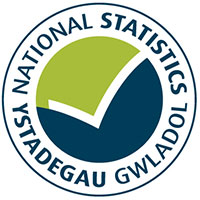For the period up to March 2019, households with an income less than 60% of the UK median, analysed by attributes such as age, economic status and family type.
This is not the latest release in the series: Relative income poverty
All figures here relate to relative income poverty in Wales after housing costs such as mortgage interest payments/rent, water rates and structural house insurance were paid.
Headline key findings
- 23% of all people in Wales were living in relative income poverty between 2016-17 and 2018-19.
- This figure has remained relatively stable for the past 16 time periods. At 23%, the figure is slightly lower than last year’s.
- Children were the age group most likely to be in relative income poverty (at 28%) and this has been true for some time. This is only the fourth time this figure has been below 30% since the period ending 2005-06.
- A possible reason for children consistently being the age group most likely to be in relative income poverty is that adults with children are more likely to be out of work or in low paid work due to childcare responsibilities.
- 22% of working-age adults were in relative income poverty between 2016-17 and 2018-19.
- This is down from the 23% reported last year. The figure has been around 21% to 23% for most of the time periods since the late 1990s.
- 19% of pensioners in Wales were living in relative income poverty between 2016-17 and 2018-19.
- At 19%, the figure is the same as that reported last year and it remains below what it was throughout the mid to late 1990s.
Analysis by economic, family, ethnicity and disability characteristics
- Working-age adults living in social rented housing were more likely to be in relative income poverty when compared with those privately renting or owner occupiers.
- Living in a workless household increased the chances of being in relative income poverty for working-age adults and children.
- Children living in lone parent families were more likely to be in relative income poverty than those living in households with a couple.
- The likelihood of being in relative income poverty was higher for those children who lived in a household with three or more children.
- People who were living in households where the head of the household was from a non-white ethnic group were more likely to be in relative income poverty.
- Living in a household where there was someone with a disability increased the likelihood of living in relative income poverty for working-age adults and children but not for pensioners.
Reports
Data
Datasets and interactive tools
Households Below Average Income data after housing costs, 2007/08 to 2018/19 (unless otherwise stated): tables , file type: ODS, file size: 81 KB
Contact
Nia Jones
Telephone: 0300 025 4088
Email: stats.inclusion@gov.wales
Rydym yn croesawu galwadau a gohebiaeth yn Gymraeg / We welcome calls and correspondence in Welsh.

